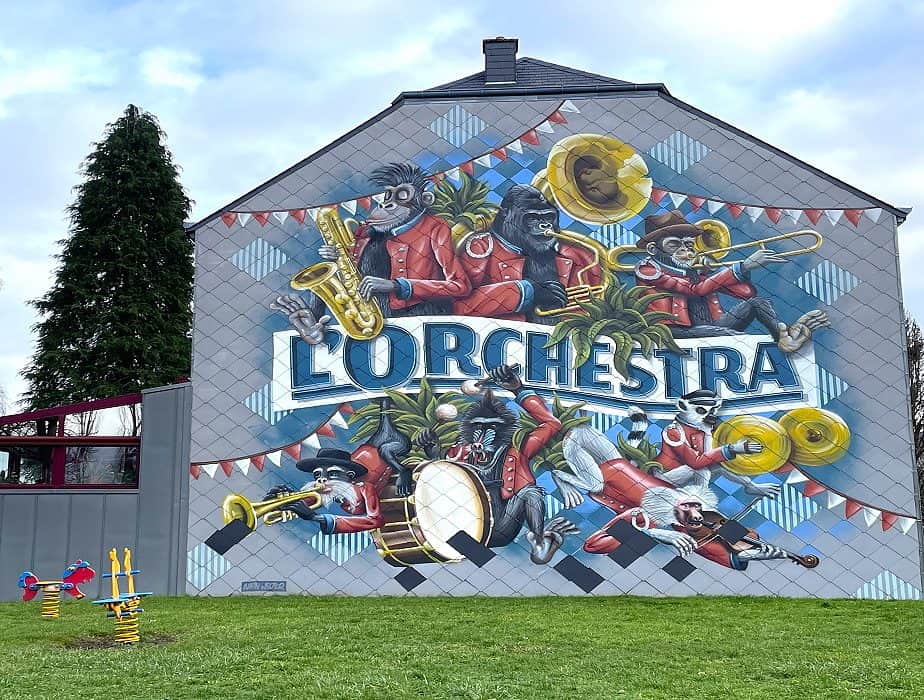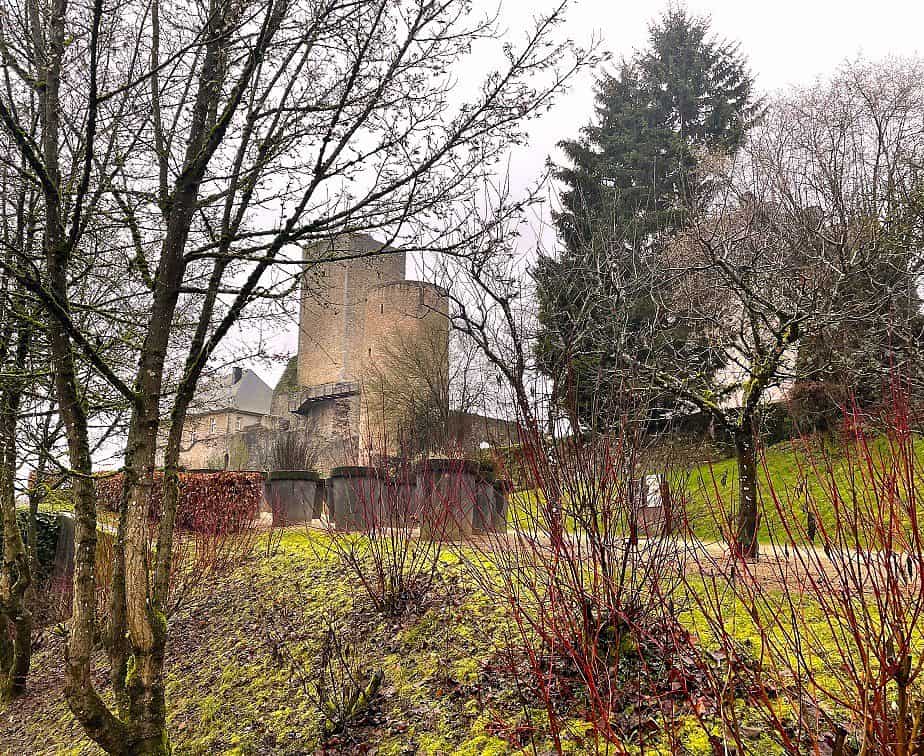25 Awesome Things To Do In Luxembourg
It may only have 600,000 people, but Luxembourg offers an impressive diversity of attractions and fun things to do despite its small size.
In Luxembourg, the old quarter of Luxembourg City, a UNESCO World Heritage Site, is home to many of the country’s best sightseeing opportunities and points of interest. Still, the country’s other small towns are lovely and worth exploring.
Additionally, traveling around the country is extremely easy. It doesn’t matter if you plan to explore by foot in the capital city, drive through the beautiful countryside, or hop from town to town by train. You’ll never run out of exciting things to see.
In combination with nearby countries such as Belgium and the Netherlands, the country is a popular tourist destination because of its old forts, castles, and beautiful scenery.
Our list of the top Luxembourg attractions will show you where to go in this charming West European country.

This post may contain affiliate links. Please read our disclosure and privacy policy for more information.
/table
About Luxembourg
Luxembourg is a small country in Western Europe, bordered by Belgium to the west, Germany to the east, and France to the south. Its population is around 600,000 people, and its capital and largest city are Luxembourg City.
The official languages are French, German, and Luxembourgish. Luxembourg is a parliamentary democracy with a constitutional monarchy and is a member of the European Union, the United Nations, and NATO.
The economy of Luxembourg is highly developed and industrialized, with a focus on banking and finance, and it has one of the highest GDP per capita in the world. The country is also known for its picturesque landscapes and historic castles.
Luxembourg Flag
The flag of Luxembourg consists of three horizontal bands of red, white, and light blue. The colors are symbolic of the country’s national motto: “Mir wëlle bleiwe wat mir sinn” (We want to remain what we are), with the red representing the nation’s courage, the white representing peace, and the blue representing perseverance. The flag was officially adopted on June 23, 1972, but has been in use in some form since the 13th century.
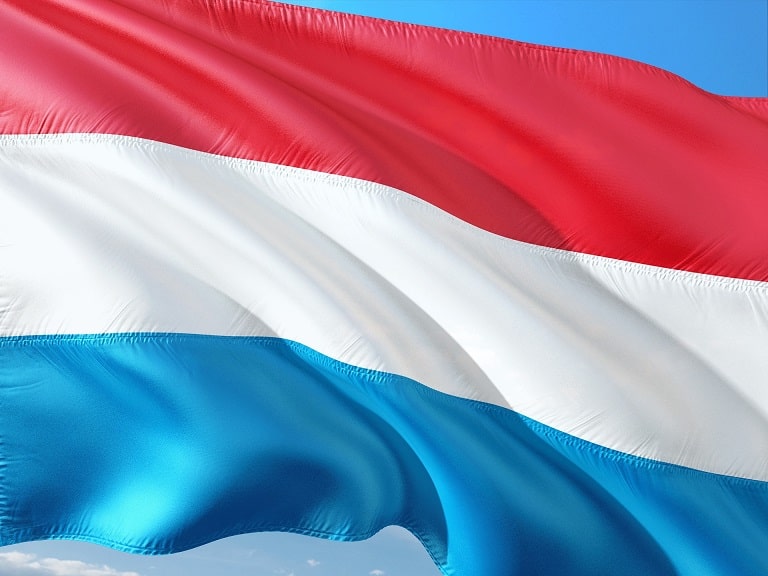
Luxembourg On Map of Europe
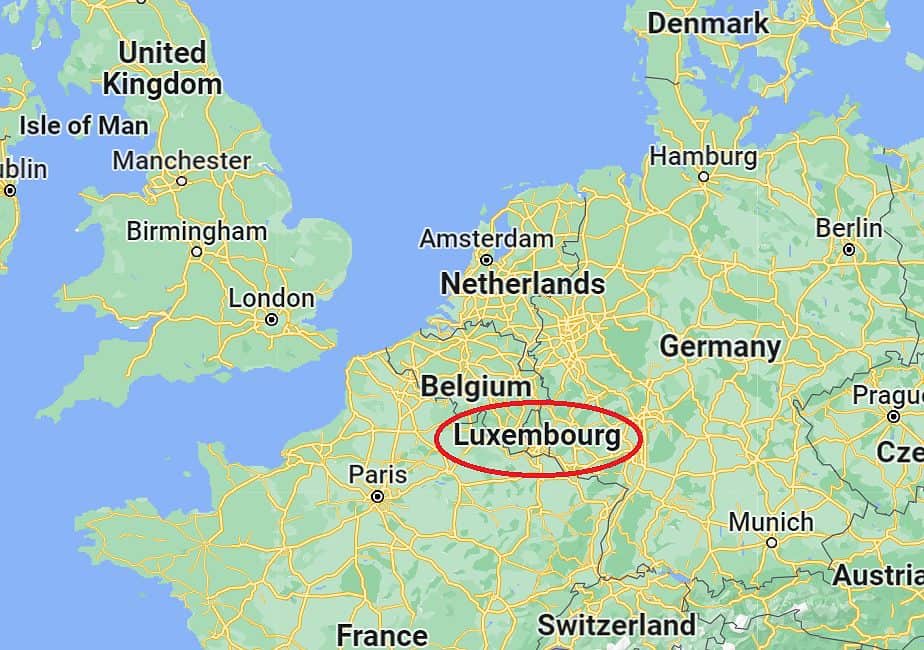
Getting To Luxembourg
Belgium borders Luxembourg to the west and north, Germany to the east, and France to the south.
There are several ways to get to Luxembourg:
- Air: Luxembourg Airport has regular flights from major cities in Europe.
- Train: Luxembourg is well connected by train to other cities in Europe, with regular services from Brussels, Paris, and Frankfurt.
- Road: Luxembourg is connected to other European cities by a network of highways, making it easily accessible by car.
- Bus: Luxembourg is also served by several international bus routes.
Luxembourg Airport
Luxembourg Airport (LUX) is the main international airport in Luxembourg. It is located about 6 km east of Luxembourg City and serves as a hub for Luxair and Cargolux. The airport offers flights to various destinations in Europe and provides a range of facilities for passengers, including restaurants, shopping, and baggage storage.
Map Of Things To Do In Luxembourg
Luxembourg Palace – Grand Ducal Palace
A must-see landmark in Luxembourg City is the Grand Ducal Palace (Groussherzogleche Palais). It was built in 1572 as the official residence of the country’s reigning monarch, Grand Duke Henri. When it was built in 1572, the building served as the city’s original city hall until 1795, when it became the Grand Ducal Palace.
Notice the guard in the photo. Two guards patrol the Palace. One marches up and down as one waits in the guard box, then they rotate.
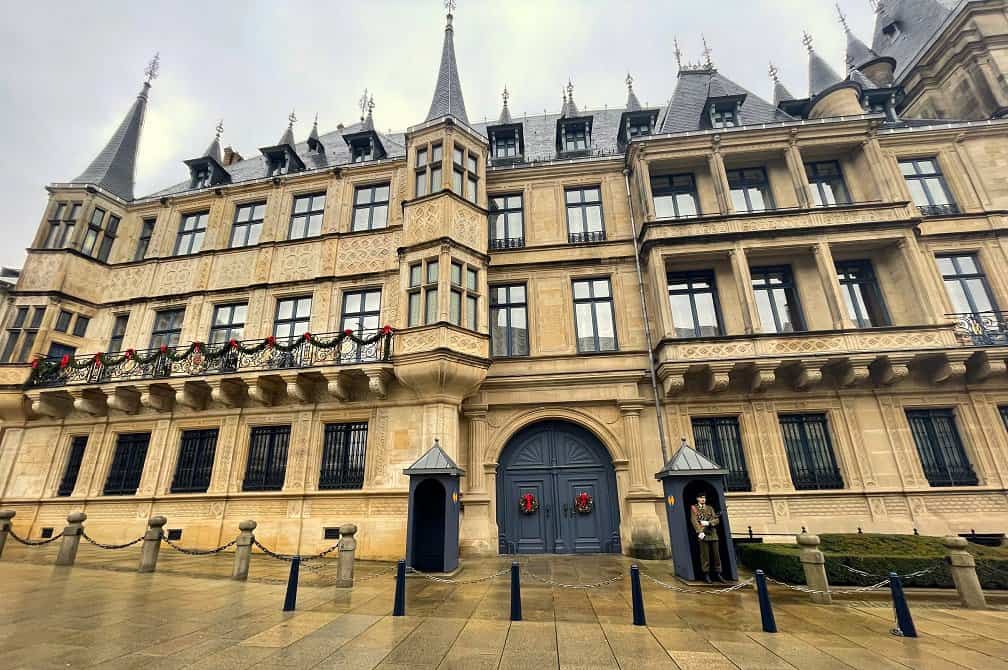
During the summer and early fall, when it becomes one of the city’s most popular attractions, specially organized tours are offered to the public, allowing them a peek inside. In addition to English, nine different tour options are available daily. Visitors can see the plush, elegantly furnished interior during the tour, including the formal rooms used for important events such as foreign dignitaries’ visits.
William Square – Place Guillaume II
Place Guillaume II (William Square) in Luxembourg City is one of the largest open spaces in the city. It was once the site of a Franciscan convent but has since been turned into a pedestrian area. William II, King of Holland and Grand Duke of Luxembourg, is pictured seated on an equestrian statue in the heart of the monument.

There are also the lions of Trémont in William Square and the lovely Town Hall. In addition to flowers and plants, the weekly market here also offers local produce.
Its beautiful façade, well-restored balcony, and spiral staircase date back to the 16th century. In addition to the Spanish Turret, there are the old cavalry barracks of Vauban, and the view of Pfaffenthal from the Spanish Turret is spectacular. Known for its three towers adorned with three acorns, Fort Thüngen is also called the “Three Acorns.”
Don’t rush through this beautiful area; take your time. This area’s many fine cafes and restaurants make it a delightful place for a meal or beverage.
The Bock Casements – Casemates du Bock
In the era of Spanish dominance, the first underground tunnels were constructed in 1644, which makes them a UNESCO World Heritage Site. Vauban, the French engineer and fortress builder, and the Austrians enlarged the 23-kilometer-long galleries only 40 years later.
Different levels of subterranean defensive passages reached as deep as 40 meters. Luxembourg earned the title “Gibraltar of the North” due to these impressive defense works.

It is estimated that 17 kilometers of the casemates were left in good condition after dismantling the fortress in 1867. Many of these fascinating fortifications can be explored on foot today, while guided tours are available to learn more about their fascinating history.
An old castle, discovered in 1963, is on the Bock plateau. In addition to the old 19th-century barracks and the remains of the Wenceslas wall, there are stunning views of the suburb of Grund and the Rham Plateau.
Public access has been available to the Bock and Pétrusse casemates since 1933. Fortress ramparts and the historically impressive Old Town of Luxembourg are listed as World Heritage Sites by UNESCO in 1994.
The Old Quarter of Luxembourg City
The Old Quarter is the place most people head to first to start exploring beautiful Luxembourg City. In 1994, UNESCO designated this beautiful old city center, locally known as “d’Stad,” as a World Heritage Site.
In addition to being one of Europe’s most strategically important cities, the city also boasted impressive ancient fortifications. It was so impregnable that it was dubbed the “Gibraltar of the North.” Although it was dismantled between 1867 and 1883, its influence is still evident throughout the Old Quarter.
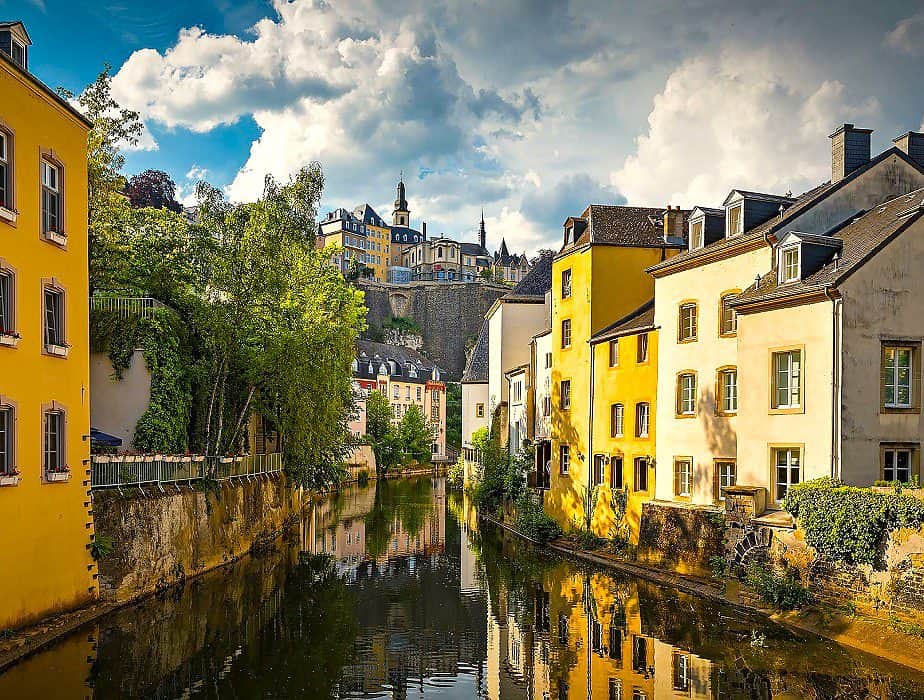
With its cobblestone streets lined with charming old homes, the old fortifications have been replaced with beautifully landscaped parks and gardens. Among its many bridges is the spectacular Adolphe Bridge, a landmark worth exploring for a few hours. In addition, you’ll pass through several exciting alleyways. Simply follow your nose instead of a map for an added dose of fun!
If you plan on arriving by car, consider using one of the excellent park-and-ride facilities in the city. There is ample public parking available. Hotel accommodations in the Old Quarter are even better if you arrive by train.
The Walls of the Corniche – Le Chemin de la Corniche
In Luxembourg City, you’ll find the big Gate of the Grund, dating from 1632, on the Walls of the Corniche (le Chemin de la Corniche). It has been called “the most beautiful balcony in Europe.” There are several aristocratic houses and refuges, the ancient Dominican convent, and St. Michael’s church (987 CE). Some call it “the most beautiful balcony of Europe”; it runs along the Alzette valley on the ramparts.
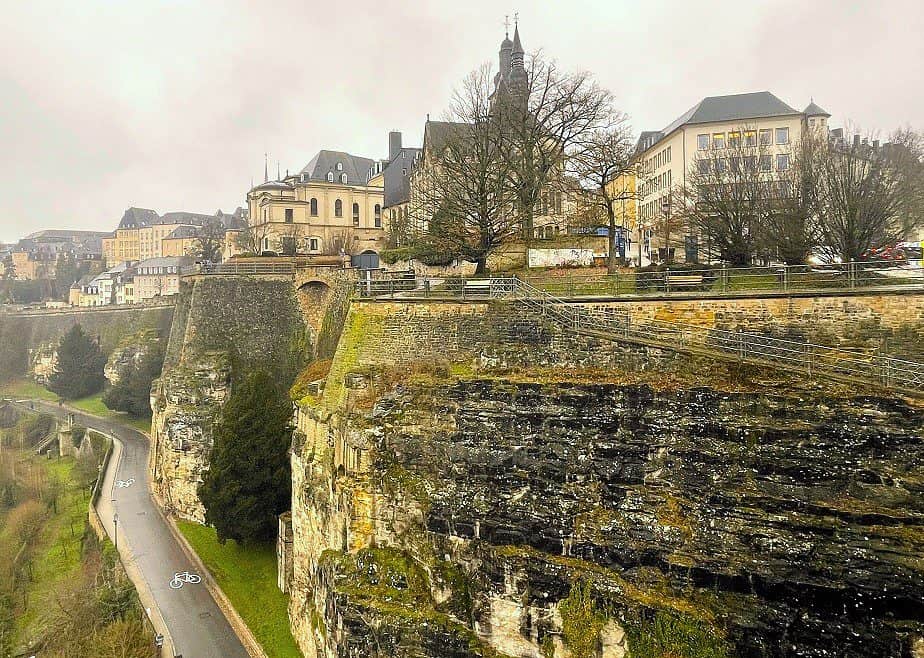
The church and ancient abbey of Neumünster are in the suburb of Grund. Among its highlights are a 17th-century Limoges cloister, a 1720 organ, and a 14th-century “black virgin.” The adjacent buildings are part of the ancient Hospice St.-Jean, founded by Emperor Henri VII, Count of Luxembourg, in 1309.
Kahler Luxembourg – The Farming Village With Graffiti Murals
Kahler “Koler” in Luxembourgish is a village in the commune of Garnich in southwestern Luxembourg. As of 2001, the town has a population of 188. This idyllic village stands out among the many scattered ones west of Luxembourg.
Graffiti artist Alain Welter has transformed his hometown. “Make Koler Kooler” is the name of his project.
Useldange
As you explore the countryside of Luxembourg in search of castles and ruins, you might make it to Useldange. Useldange, a small town, is home to the towering castle ruins of Castle Useldange. However, this town is also home to one of the most unforgettable stays in Luxembourg – The Mushroom Hotel Luxembourg.
MNHA – National Museum of History and Art – Musee National d’Histoire et d’Art
Despite being one of Europe’s most historical cities, Luxembourg City is still among the continent’s must-see cities based on the quality of its museums alone. The National Museum of History and Art (National Museum of History and Art, or MNHA) takes the top spot on the list.
You’ll find it in the historic Fish Market area, once known as the town center. Artifacts, archeological finds, furniture, tools, coins, arms, and documents relating to the country’s history are all housed in the stunning new building of the MNHA.

From the 16th to the early 20th centuries, there were numerous displays illustrating the artistic, social, religious, and intellectual life of Luxembourgers during the Gallo-Roman period. Many of the most influential artists of the 20th century are featured in the contemporary art section. On-site amenities include a research library, shop, and guided tours in English.
Art lovers should also visit the unique Am Tunnel or Galerie d’Art Contemporain Am Tunnel. This contemporary art gallery, which occupies an old tunnel as its name suggests, offers a pleasant respite from the city’s many more significant, busier museums and galleries.
MUDAM – Grand Duke Jean Museum of Modern Art
A visit to the Grand Duke Jean Museum of Modern Art (Musée d’art moderne Grand-Duc Jean) is a must for lovers of modern art and ultra-modern architecture. One of Europe’s most important art galleries, MUDAM is known for its contemporary art collections created by world-renowned artists.
MUDAM has consistently drawn rave reviews for its sizeable contemporary collection since its opening in 2006. To name a few, the exhibit includes works by Bruce Nauman, Andy Warhol, and Julian Schnabel.
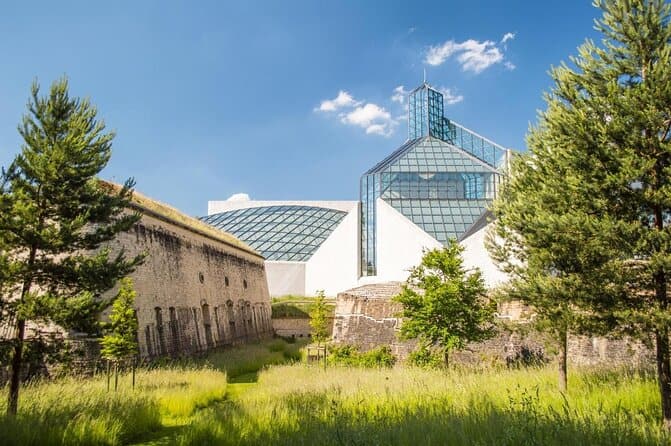
There are also many temporary and visiting exhibits at the museum, in addition to its fine permanent collections. Children are also welcome to attend various first-rate educational programs and workshops.
A large shop selling related gifts and souvenirs is located on-site, as is a great café. Guided tours are also available in English.
Walferdange Castle – Château de Walferdange
The castle of Walferdange (Château de Walferdange), which served as the Grand Ducal residence until the end of the 19th century, is located at the entrance to Grunewald Wood. The university is just a short distance from Luxembourg City, making it a great day trip from one of Luxembourg’s primary tourist routes.
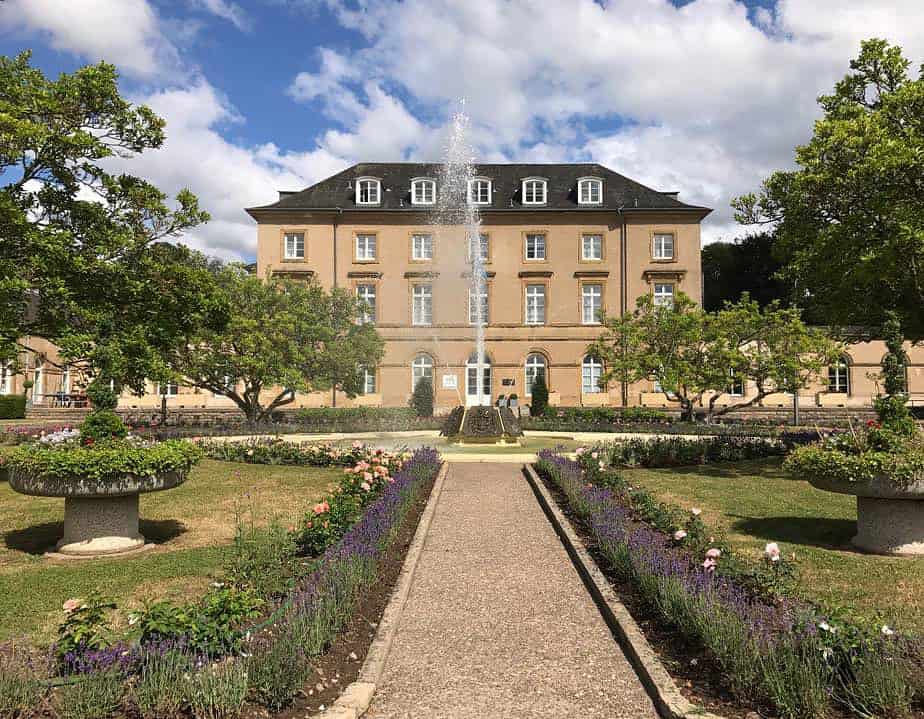
Located at the junction of the Alzette Valley and its lovely wooded heights, Walferdange itself boasts picturesque scenery. The village is also famous for its rose gardens and great views. There is also an underground aqueduct and a Roman villa worth visiting on the archeological site.
The Walfer Shopping Center has also made Walferdange a popular shopping destination.
The Luxembourg Ardennes
Unlike Luxembourg City’s relatively flat landscape, the Ardennes offers high forested plateaus, sheer cliffs, wooded hills, hidden valleys, and countless impressive views. This picturesque region, famous as the place where Hitler staged his last major campaign of WWII, boasts numerous castles, fortresses, and fortified farms rising out of the hilltops. Wiltz is famous for its open-air theater and music festival and is one of the prettiest towns in Germany.
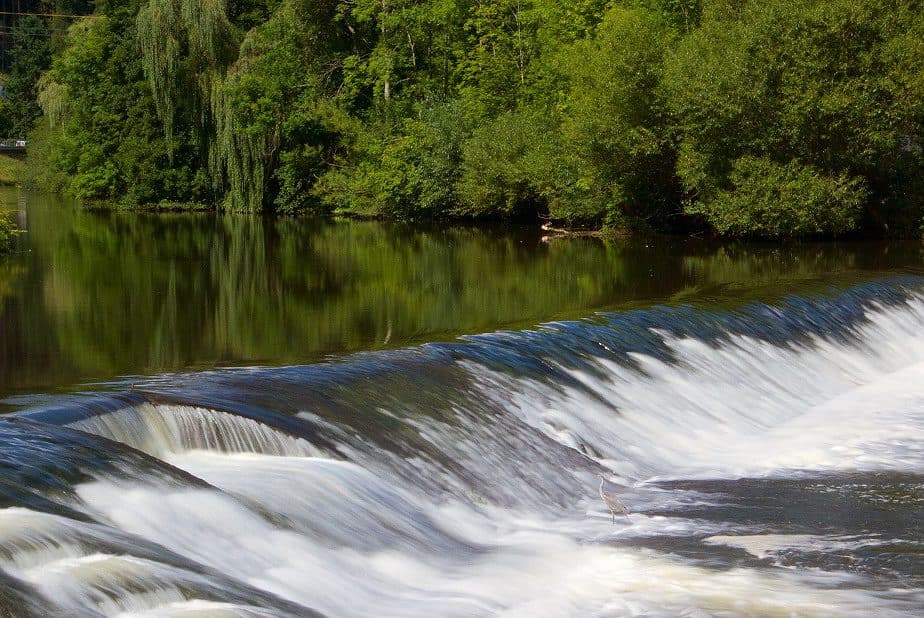
Wiltz Castle also has a Battle of the Bulge Museum. Ettelbruck has a WWII-themed museum and monument dedicated to General Patton. It is also worth visiting the quaint village of Clervaux. Located along the river Clerve, the village is home to the Benedictine Abbey of Saint Maurice and Saint Maur. This Romanesque-Burgundian-style monastery was built in 1910 and dominated the valley. In addition to Gregorian masses, visitors can view exhibits about monastic life.
Grand Duchess Charlotte Bridge
Located in Luxembourg City, southern Luxembourg, the Grand Duchess Charlotte Bridge (Luxembourgish: Groussherzogin-Charlotte-Bréck) crosses the Grand Canal. It connects Avenue John F. Kennedy in Kirchberg to Boulevard Robert Schuman in Limpertsberg by crossing the Alzette. Due to its distinctive red paintwork, it is known as the Red Bridge.
Kirchberg is the site of the European Union’s institutions and is connected to the city center, Ville Haute. It is 355 meters long, the clear span between the pillars is 234 meters, the width is 25 meters, and the total weight is 4,900 tons.
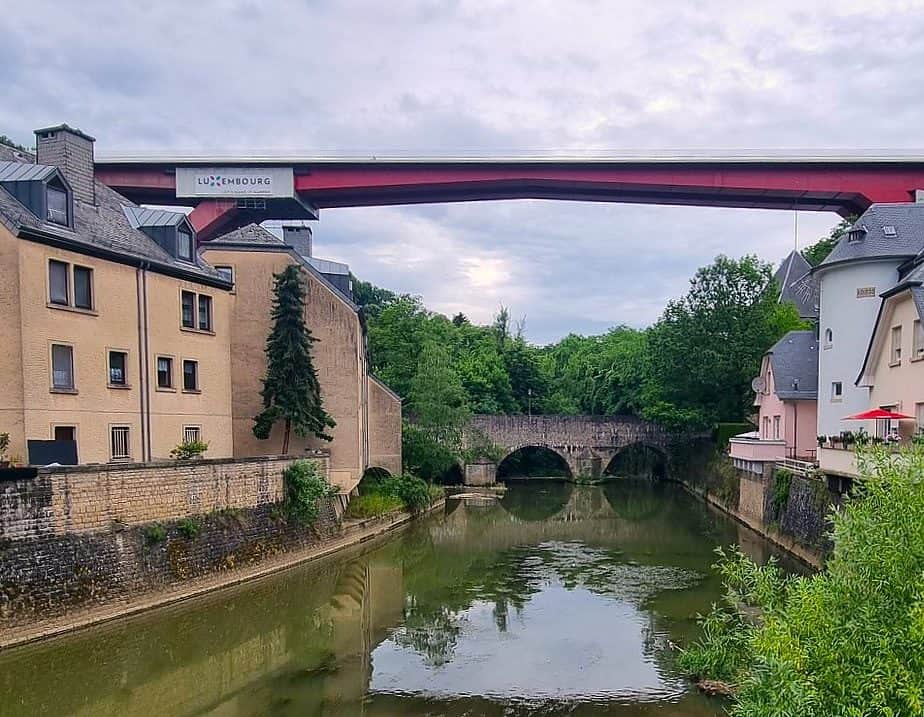
Pfaffenthal Panoramic Elevator
A public elevator in Luxembourg City called the Pfaffenthal Panoramic Elevator connects the historic city center, Ville Haute, and Pfaffenthal, located in the Alzette Valley.
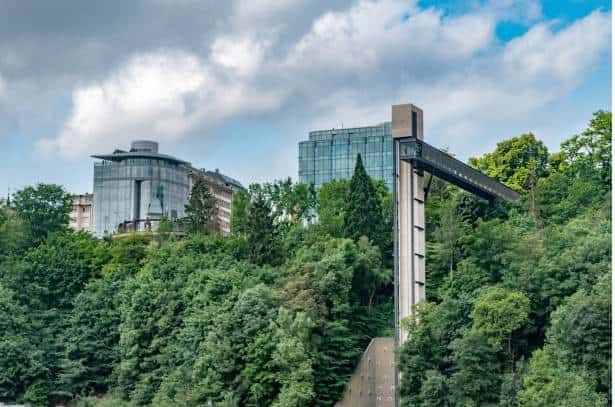
As well as providing a panoramic view of the Alzette River valley and connects Luxembourg City’s elevated city to the city quarters located in the Alzette and Petrusse river valleys with the Pfaffenthal elevator, the Grund public elevator, and the Pfaffenthal-Kirchberg funicular.
Luxembourg City History Museum
This museum offers a fascinating insight into the rich 1,000-plus-year history of Luxembourg, one of the newer attractions in the city. Several old homes in the building date from the 17th and 19th centuries, some with even older medieval sections, like the recently discovered vaulted cellars. Modern extensions of the museum contrast impressively with these. In the exhibits, you can learn about the early inhabitants and the evolution of the settlement over time.

Besides providing beautiful views of the city’s historic Grund district, the museum has an elevator and viewing area. English is also available for workshops and guided tours. Visit the National Museum of Natural History (Nationalmusée fir Naturgeschicht) if you plan on doing some museum hopping during your stay. Locally and globally, this popular Luxembourg City attraction features natural world exhibits.
Bourscheid Castle
Sûre and Wark’s rivers surround the village of Bourscheid, which is located on a plateau. You can hike here to other quaint villages, including Michelau in the Sûre Valley, Welscheid in the Wark Valley, and Kehmen on the plateau. Both Bourscheid-Plage and Dirbach have river beaches for sunbathers.
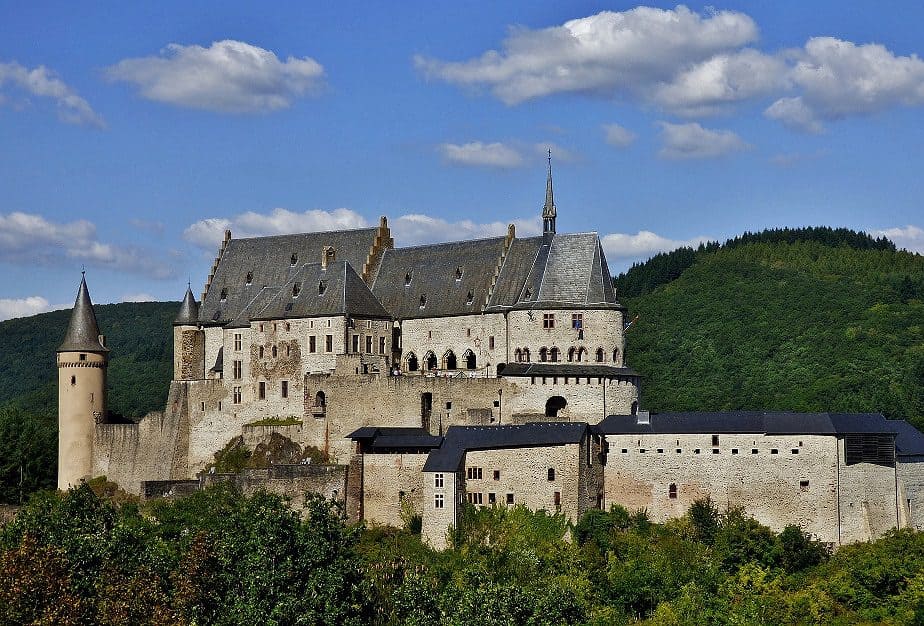
The ruins of the Bourscheid Castle dominate this region of the Ardennes. On a rocky peak 137 meters above the Sûre, this fairy-tale fortress dominates the surrounding countryside. A restored castle dating from the 10th century is accessible to visitors today. On request, English-language guided tours are also available, as well as self-guided audio tours.
Viewing the castle after dark, when it is illuminated, is a fun nighttime activity. Especially when viewed from the village, this is one of the best free activities in Luxembourg.
Mondorf-les-Bains and the Moselle
The Moselle features slopes flanking the majestic Moselle River in the eastern part of the country. Moselle’s picturesque villages are fun to explore and renowned for their diverse cuisine based on locally grown ingredients.
Additionally, it was a favorite area of the Romans. Due to this, many Roman archaeological remains are all throughout the region.
The thermal springs in Mondorf-les-Bains, a small town in the region, are a must-see. This large spa complex, which includes a health center, sports club, and hotel, is one of the top tourist attractions.

Some springs supply the complex’s thermal installations with mineral water at a temperature of 24 degrees Celsius, which is well known for its medicinal properties.
Visit Mondorf Park to see its extensive collection of trees, shrubs, and flowerbeds afterward. Among the other highlights are the art nouveau houses and the 18th-century St. Michael’s Church, with its furniture and frescoes.
Upper Sûre Natural Park and Esch-sur-Sûre
The Upper Sûre Natural Park (Naturpark ewersauer) is a breathtaking natural landscape characterized by plateaus, narrow valleys, and wooded slopes. As well as being a popular leisure and water sports destination, it is also a popular ecotourist destination.
From pleasant circular tours to more challenging treks around the lake, many walking tours are available, including guided and self-guided options. The large reservoir has been enhanced with a sculpture trail and excellent solar-powered boat tours. Fishing, swimming, sailing, and diving are fun activities in Upper Sûre Natural Park.

Cultural heritage is also abundant in the area. It includes a museum with exhibits relating to the park and the surrounding area, housed in an old cloth mill. Several regular events are also held here, the largest of which is the biennial Water Art Festival, which attracts more than 200 musicians under the theme “Rock meets Classic.” Esch-sur-Sûre is a must-see nearby.
This is one of the country’s most outstanding sites, nestled in the mountains and skirted by the river Sûre. In this village, the ruins of a manor house from AD 927 dominate the landscape, as do the cliffs that look down to the river. Free admission is offered year-round to the mansion.Address: Nature ParkCentre, 15, Rue de Lultzhausen L-9650 Esch-sur-Sûre, Luxembourg
Echternach and Benedictine Abbey – Abbey of Echternach
In Echternach, the River Sûre forms the border with neighboring Germany, forming a beautiful town. The nearby Müllerdall and Germano-Luxembourg Nature Parks offer a variety of hiking paths leading to rock formations, waterfalls, a lake, and numerous picturesque viewpoints.
The town is well known for its centuries-old dancing procession, which takes place on Whit Tuesday and attracts visitors worldwide. The old aristocratic houses, narrow streets, and ancient ramparts have helped Echternach maintain its medieval appearance.
Echternach Abbey, a seventh-century building, is a must-see. A large square courtyard surrounds the four long wings of this former Benedictine monastery, which is known for its excellent museum. There is a magnificent white marble sarcophagus containing the remains of St. Willibrord in the basilica, the country’s most important religious building. Willibrord built the abbey in the 10th century, and its vaults are covered in frescoes.
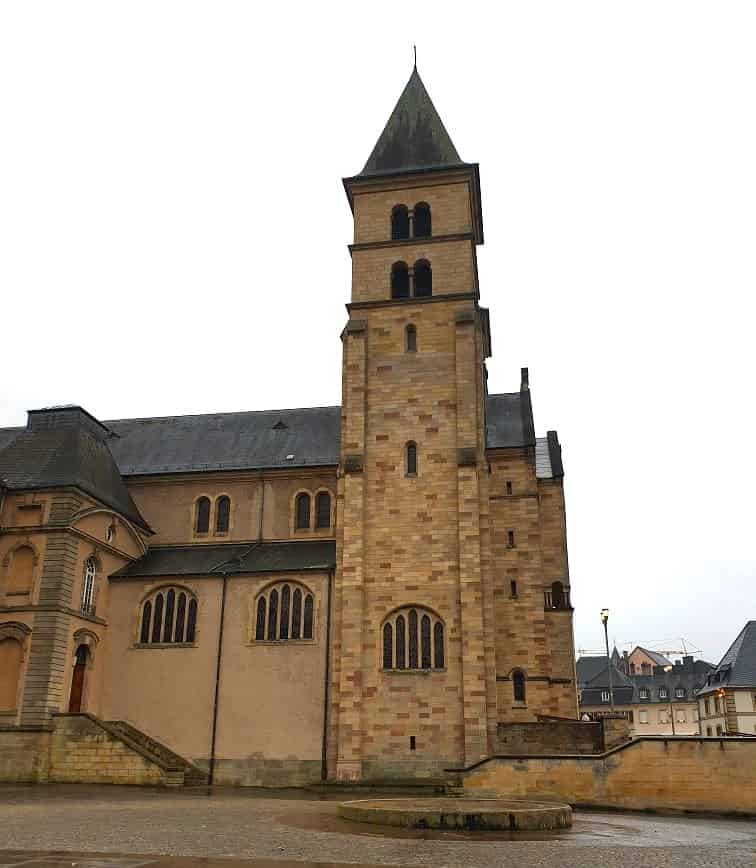
In May and June, Echternach hosts an international music festival. A variety of top-rated hotels, boutique shops, galleries, and restaurants provide great dining in the town.
Notre-Dame Cathedral
Luxembourg City’s Notre-Dame Cathedral (Kathedral Notre-Dame) was built in the late Gothic style during the early 17th century, adding Renaissance features later. There are three distinctive towers at the country’s only cathedral, including the west tower, which dates back to 1621, and two original choir bays.

Baroque angels sculpted around the organ tribune, dating back to the early 1600s, are also noteworthy. At the cathedral cemetery, you will also find a sobering memorial to the resistance movement and victims of deportation during World War II. A Sunday evening mass at the cathedral is a good option for visiting Catholics. It is typical for the Archbishop of Paris to participate in this regular service.
Larochette
Larochette is a quaint old market town in a narrow, rocky valley surrounded by woods. Two old and partly rebuilt castles dominate the city on a crag high above the White Ernz valley.
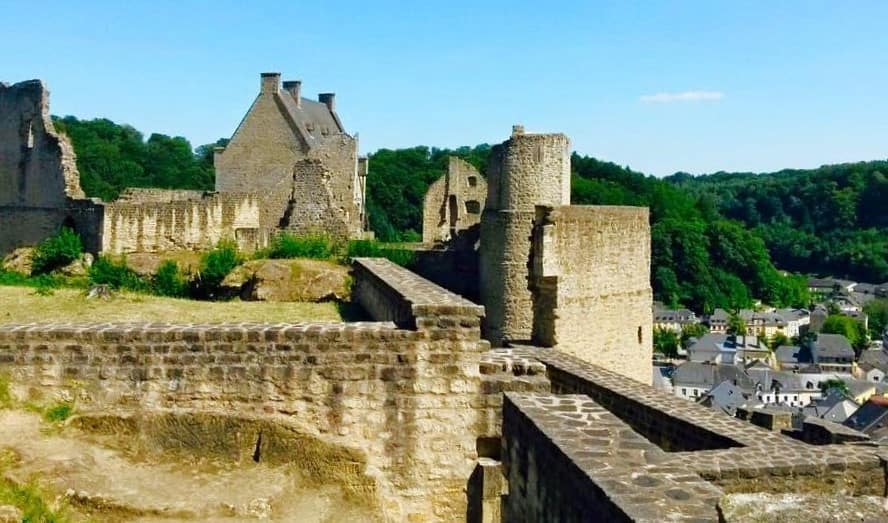
In addition to a tremendous medieval square, the town boasts a free museum of an industry that offers a fascinating look at the area’s past as an essential textile hub. Many of the city’s old streets are dotted with historical monuments. Art Nouveau frescoes is in the Neo-Roman church.
In the woods and countryside of the village, hikers will find walks for all abilities. Meysembourg and Nommerlayen castles and the remains of a Roman camp at Aalburg are some of the more unique viewpoints. Numerous campsites cater to backpackers and fine old hotels and inns.
Berdorf
Located on a vast tableland overlooking the valleys of the Black Ernz, the Sûre, and the Aesbach rivers, Berdorf is a popular tourist destination in the Grand Duchy of Luxembourg.

Over 300 acres of forest surround the valleys, chasms, tall rocky hills with fine views, numerous well-kept footpaths, and hiking trails. The Mullerthal Trail connects the Berdorf and Echternach, a picturesque village, over 112 kilometers. In addition to rock climbers and hikers, Berdorf is also a popular destination for campers, hikers, and campers.
Beaufort Castle – Buerg Beaufort
There is a Neo-Gothic church and a near-perfectly sized 12th-century castle in Beaufort, which lies on a plateau in Mullerthal. Beaufort Castle (Buerg Beaufort) is a beautiful place to explore, although much of it is now in ruins.

Don’t forget to bring your walking shoes. The Sûre valley has many footpaths leading through wooded hills to incredible views of the surrounding countryside, spectacular rock formations, and the gorges of the Hallerbach and the Saueracht towards Grundhof and Dillingen.
Vianden Castle – Buerg Veianen
Vianden lies on both sides of the River Our, making it one of the most picturesque towns in Europe. In the Ardennes and Eifel, Vianden Castle (Buerg Veianen) is unsurpassed for its architectural significance due to its ninth-century origins. There are also many impressive guard towers on the medieval outer wall surrounding the town.

The annual Vianden Medieval Festival is an excellent time to visit if you can. There are jousting and sword fighting tournaments, a market, and a knights’ camp at this popular family-friendly event on the first weekend of August. Two naves of the parish church are also worth seeing. The building was built in the Gothic style in 1248 and was recently restored. It houses a lapidary museum that tells the story of the region’s once-important stone- and gem trade—the former Trinitarian cloister dates from 1250. An 18th- and 19th-century art museum is housed in a former mansion.
Victor Hugo’s exile house in Vianden now houses a collection of souvenirs from his visits to the city during his exile in 1871. Well-maintained and signposted walking paths offer access to the beautiful countryside of the Our valley. A chairlift climbs to a height of 440 meters from where visitors can enjoy magnificent views.
Parc Merveilleux
Each year, thousands of visitors visit Parc Merveilleux in Bettembourg, just six miles from the capital city and three miles from the French border.
This amusement center has rides and attractions themed after fairy tales, including a playground, mini-train, pony express, mini-golf, restaurants, and concerts for all ages.

The zoo houses exotic birds, reptiles, and numerous cute and cuddly mammals.
FAQs
What is Luxembourg most famous for?

Luxembourg is famous for several things, including:
1. Its status as a wealthy financial center and tax haven.
2. Its strong economy and high standard of living.
3. Its beautiful castles and fortresses.
4. Its picturesque countryside and natural beauty.
5. Its role as one of the founding members of the European Union.
Why is Luxembourg so rich?

Luxembourg is rich due to its strong economy, low taxes, and stable political system. It has a high standard of living and is a hub for financial and banking services and a major center for investment funds and insurance companies. Additionally, its favorable geographical location at the heart of Europe contributes to its prosperity.
Is Luxembourg Dutch or German?

Neither. Luxembourgish is the official language of Luxembourg, and German and French are also common.
Is two days enough for Luxembourg?

You can see most of the most popular tourist attractions in two days. However, if you only have two days you will be in a rush and will not get to visit all of the castles or the countryside.
Is Luxembourg City worth visiting?

It’s where some of the most famous and historic sites are!
Closing Thoughts
Luxembourg might be a small country, but there is no shortage of things to do. We’ve given you 25 awesome things to do in Luxembourg, but there are other hidden gems!
Looking for more on Luxembourg? Start Here:
- Interesting Facts of Luxembourg – The Fun Ones!
- Kahler Luxembourg – The Farming Village With Graffiti Murals
- The MushRoom Hotel Luxembourg
- Useldange Castle, Luxembourg
- Walker’s Haute Route: The Best Hiking Guide
We participate in the Amazon Services LLC Associates Program, an affiliate advertising program designed to provide a means for us to earn fees by linking to Amazon.com and affiliated sites.
Brit On The Move™ Travel Resources
Ready to book your next trip? Use these resources that work:
Was the flight canceled or delayed? Find out if you are eligible for compensation with AirHelp.
- Book your Hotel: Find the best prices; use Booking.com
- Find Apartment Rentals: You will find the best prices on apartment rentals with Booking.com’s Apartment Finder.
- Travel Insurance: Don’t leave home without it. View our suggestions to help you decide which travel insurance is for you: Travel Insurance Guide.
- Want to earn tons of points and make your next trip accessible? Check out our recommendations for Travel Credit Cards.
- Want To Take A Volunteer Vacation or a Working Holiday? Check out the complete guide to how here!
- Want to Shop For Travel Accessories? Check out our Travel Shop.
Need more help planning your trip? Visit our Resources Page, which highlights the great companies we use for traveling.
